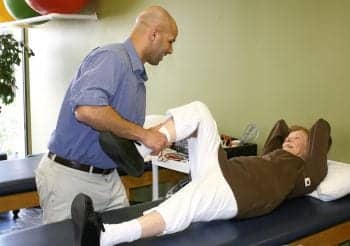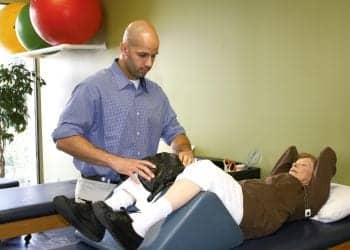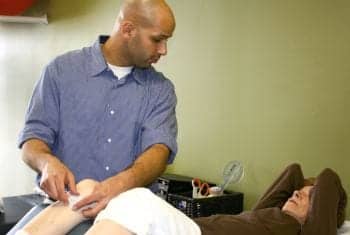
Passive range of motion is a manual therapy staple during the rehabilitation process after a joint replacement to restore joint mobility.
Osteoarthritis (OA) of the hip and knee is increasingly common in the United States and has become a major cause of disability among older adults. According to the Centers for Disease Control and Prevention, OA affects 13.9% of adults aged 25 years and older and 33.6% of those aged 65 years and older.1 As the Baby Boomer generation continues to age, the prevalence of OA is bound to rise at a rapid rate, leaving many in search of effective treatment methods to ease pain and improve quality of life. One of the more commonly used interventions is hip/knee joint arthroplasty. From 1996 to 2006, the incidence rate rose by 33% (hip) and 70% (knee).1 The most common reasons for undergoing joint replacement are debilitating pain and decreased quality of life due to osteoarthritis. Whether a weekend warrior, avid golfer, or grandmother of seven, more and more people with OA will explore the possibility of joint arthroplasty to remain active members of their communities and maintain a high quality of life.
Advances in technology have made hours-long surgeries and arduous recovery processes a thing of the past as individuals, post-hip and knee joint replacement, are up and walking within hours of surgery. Rehabilitation typically begins at the hospital and consists of gait training, light exercise, and fitting of an assistive device, such as a walker or cane.
Once outpatient physical therapy begins, the focus turns to improving strength, range of motion (ROM), and functional mobility through manual therapy and therapeutic exercise performed by a physical therapist (PT). Manual therapy often includes joint and soft tissue mobilization to increase ROM, decrease edema, and improve muscle function. Exercise is initiated to develop foundational strength and slowly increases in intensity as the patient continues to show strength gains. According to one study, physical therapy intervention, which included manual therapy and exercise, was shown to improve outcomes related to physical activity following total knee arthroplasty.2 Each individual’s plan of care is tailored to postsurgical goals, lifestyle, and activity level.
Postsurgical pain is very common post-joint replacement and can range from minimal to severe.3 PTs often turn to therapeutic modalities in order to help control postoperative pain, swelling, and joint restrictions. Modalities are physical agents used to achieve a desired physiologic response such as increasing circulation, decreasing pain, and promoting tissue healing. Regardless of the modality’s mechanism for change, pain management is a primary indication for use, and a multitude of options is available for the patient or clinician looking to accomplish this goal.

The use of cryotherapy early in the rehabilitation process helps speed up the healing process while decreasing recovery time following treatment.
Commonly used modalities include ultrasound, low level laser therapy, topical analgesics, hot/cold therapy, and electrical stimulation.
ULTRASOUND
Ultrasound uses high frequency sound waves to penetrate superficial and deep tissue in order to relieve pain, improve tissue extensibility, and increase local circulation. Ultrasound can provide both thermal and nonthermal effects, which are chosen based on patient presentation. In relation to OA, one study showed that “ultrasound treatment significantly alleviates joint symptoms, relieving joint swelling, increasing joint mobility, and reducing inflammation, in osteoarthritis patients.”4 Ultrasound is readily available and can be used in conjunction with traditional physical therapy to have a positive therapeutic effect on persons diagnosed with OA.5
In addition, ultrasound is commonly used to treat individuals who are post-total knee and hip arthroplasty, but care must be taken with implants made of cement/plastic/metal components, as excessive heat can have a negative effect on the hardware.
LOW LEVEL LASER
Low level laser therapy, although not as commonly used as other modalities, has shown signs of effectiveness when used in conjunction with other therapeutic techniques. One study found that “low level laser therapy when associated with exercises is effective in yielding pain relief, function and activity on patients with osteoarthritis of the knees.”6 In addition, laser therapy has shown positive effects in speeding up tendon tissue healing time, which can be beneficial in the total joint replacement population as patellar tendonitis and iliopsoas (hip flexor) tendonitis are common pre- and post-total joint replacement.
Photons from the laser beam promote tissue healing to help stimulate cell growth, repairing microtears within the tendon. The improvement in circulation and oxygen supply to the tissue that results from the treatment will not only decrease inflammation, but also improve the strength of the tendon itself. More and more literature continues to support the use of this modality in many orthopedic conditions, including cases of joint replacement.

Electrical stimulation is key in rehabilitation following a joint replacement, helping to manage pain, reduce inflammation, and increase circulation.
TOPICAL ANALGESICS
Non-steroidal anti-inflammatory drugs (NSAIDs) are a staple in the postsurgical population. There is an abundance of literature that demonstrates the effectiveness of oral NSAIDs in helping decrease pain and inflammation, improve circulation, and promote tissue healing. For topical NSAIDs, the primary benefit is created by the path taken to the painful area, as a topical NSAID does not go through the stomach or bloodstream. This action helps minimize the side effects of the topical NSAID and allows administration to a very local area. In fact, recent studies have shown that topical NSAIDs are just as effective as oral NSAIDs in treating osteoarthritis, especially in the knees.7 A recent literature review showed that there is “substantial evidence supporting the efficacy and safety of topical NSAIDs” in the osteoarthritic population.7
One study showed that topical NSAIDs were highly effective in decreasing pain levels in individuals with osteoarthritis over a 2-week period. The efficacy for long-term pain management has not been supported, which can pose a problem in terms of medication overuse and financial constraints.8
HOT AND COLD THERAPY
Ice and hot packs have been used in rehabilitative settings for years. If you walk into a PT clinic anywhere in the country, you are bound to see someone set up on a hot pack on their low back to help loosen tight muscles, or a cold pack around their ankle to cool down post-exercise. But how effective are hot and cold therapies in decreasing pain in individuals with osteoarthritis?
Cryotherapy (cold) has three main goals: decrease pain, reduce muscle spasm, and limit circulation. Immediately following a traumatic event (surgery, acute injury, etc), cryotherapy functions to limit the accumulation of swelling in a joint via vasoconstriction of blood vessels, keeping fluid out of a specific area. It decreases pain by acting as a “numbing” agent, slowing down nerve conduction of the painful signal sent to the brain. One study found that cryotherapy had a significant reduction in pain levels on the Visual Analog Scale (VAS) in addition to providing lasting pain relief throughout the recovery process in individuals who underwent a total hip arthroplasty secondary to OA.9
To better increase the effectiveness of cryotherapy, compression and elevation should be done in conjunction to increase contact area of the cooling agent to the affected tissue. In fact, one study found that combining ice and compression decreased pain levels in patients postoperatively by 49% versus only a 41% reduction in the control group (ice without compression).10 Ice massage also has shown effectiveness in increasing range of motion and function in the OA population. 11
Heat therapy, on the other hand, has two main goals: relax muscle and improve circulation. Heat is best used more than 10 days to 14 days after a surgery/traumatic event, or when there are no longer signs of inflammation. Heat therapy can be very effective in loosening up “stiff” joints or relaxing “tight” muscles, which can be extremely beneficial in the joint arthroplasty population as joint stiffness is very common post-replacement. However, in the presence of swelling, heat therapy can actually have a negative effect, as vasodilation of the blood vessels makes it easier for fluid to travel, which can allow swelling to pool in the postsurgical area.
The most common methods of applying heat include a hot pack, moist heat (hot towel), or taking a hot shower/bath.
TRANSCUTANEOUS ELECTRICAL NERVE STIMULATION (TENS)
TENS is one of the more commonly used pain management strategies post-hip and knee replacement. It utilizes electrical stimulation designed to help prevent pain signals from being sent to the brain, thus not allowing pain to be perceived. One major advantage of using TENS is that it is primarily utilized as a portable unit, which allows the individual the ability to be mobile while using the device whether in a clinic environment or at home. In some individuals, pain relief can last for several hours and TENS has been shown to be mildly effective as a supplement to decreasing the use of oral pain medication.
Over the years, there has been a lot of discussion about the effectiveness of TENS units for chronic versus acute pain. Although the literature is divided in terms of chronic pain, there have been a number of reviews and meta-analyses that have confirmed the efficacy of TENS units with postoperative pain, osteoarthritis, and chronic musculoskeletal pain.12
With so much scrutiny by insurance companies over billing procedures, recent talk has centered around the possibility of Medicare denying reimbursement for electrical stimulation-related treatments, TENS included. Loss of reimbursement would have an enormous negative effect on pain management in the joint replacement population due to its proven effectiveness and frequency of use both in the clinic and as part of a patient’s home program. Without the potential of reimbursement for this service, the loss would challenge the creativity of clinicians, as TENS would lose its position as a staple in pain management programs. Patients also would have increased difficulty with self-managing their pain, as acquiring a portable TENS unit for home use would be more difficult.
Pain management is a significant factor in postreplacement rehabilitation, as pain relief is typically the reason an individual chooses this treatment route in the first place. With recent technological advancement and so many options available at the fingertips of clinicians, the decision to undergo a joint replacement could be the first step to a pain-free life.
Ziad Adel Dahdul, PT, DPT, is a physical therapist at Precision Rehabilitation, an outpatient neurologic/orthopedic facility in Long Beach, Calif. He received his clinical doctorate in physical therapy from the University of Southern California in 2010. Dahdul specializes in orthopedic physical therapy across the lifespan and has experience treating musculoskeletal disorders in the neurologic population. He has been a clinical instructor for physical therapy students across Southern California. For more information contact
REFERENCES
- Osteoarthritis. Available at: www.cdc.gov. Accessed April 21, 2012.
- Akodu AK, Giwa SO, Akinbo SR, Ahmed UA. Physiotherapy in the management of total knee arthroplasty: a review. Nig Q J Hosp Med. 2011;21:99-105.
- Wylde V, Hewlett S, Learmonth ID, Dieppe P. Persistent pain after joint replacement: prevalence, sensory qualities, and postoperative determinants. Pain. 2011;152:566-72.
- Yang PF, Li D, Zhang SM, et al. Efficacy of ultrasound in the treatment of osteoarthritis of the knee. Orthop Surg. 2011;3:181-7.
- Köybasi M, Borman P, Kocaoglu S, Ceceli E. The effect of additional therapeutic ultrasound in patients with primary hip osteoarthritis: a randomized placebo-controlled study. Clin Rheumatol. 2010;12:1387-94.
- Alfredo PP, Bjordal JM, Dreyer SH, et al. Efficacy of low level laser therapy associated with exercises in knee osteoarthritis: a randomized double-blind study. Clin Rehabil. 2012;25:523-33.
- Altman RD, Barthel HR. Topical therapies for osteoarthritis. Drugs. 2011;71:1259-79.
- Mason L, Moore RA, Edwards JE, Derry S, McQuay HJ. Topical NSAIDs for chronic musculoskeletal pain: systematic review and meta-analysis. BMC Musculoskelet Disord. 2004;19:5-28.
- Saito N, Horiuchi H, Kobayashi S, Nawata M, Takaoka K. Continuous local cooling for pain relief following total hip arthroplasty. J Arthroplasty. 2004;19:334-37.
- Meyer-Marcotty M, Jungling O, Vaske B, Vogt PM, Knobloch K. Standardized combined cryotherapy and compression using Cryo/Cuff after wrist arthroscopy. Knee Surg Sports Traumatol Arthrosc. 2011;19:314-9.
- Brosseau L, Yonge KA, Robinson V, et al. Thermotherapy for treatment of osteoarthritis. Cochrane Database Syst Rev. 2003;4:CD004522.
- Johnson M, Martinson M. Efficacy of electrical nerve stimulation for chronic musculoskeletal pain: a meta-analysis of randomized controlled trials. Pain. 2007;130:157-165.




